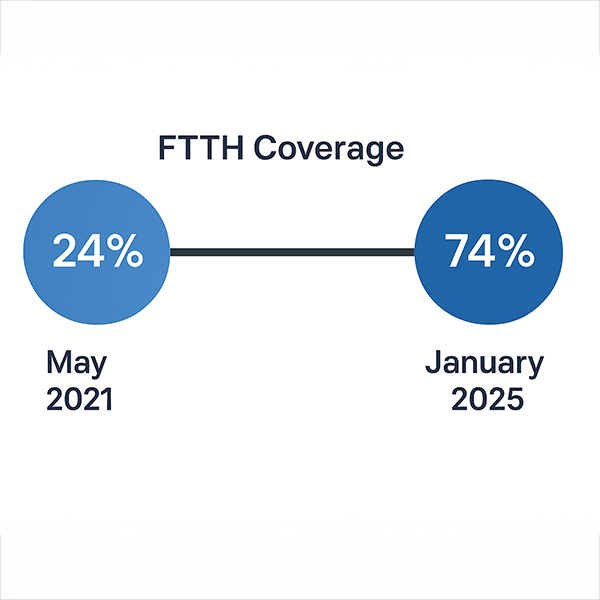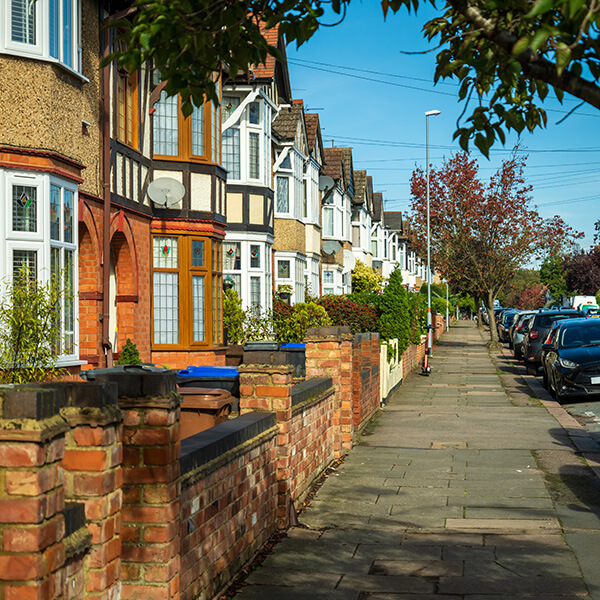The recent ISPA and Connected Britain 2025 events highlighted how far the UK’s fiber-to-the-home (FTTH) journey has come — and where it’s headed next. With large-scale rollouts nearing completion, the spotlight is shifting from building infrastructure to connecting homes, enhancing user experience, and unlocking the full potential of fiber broadband. Here are some reflections on what we can expect in the UK fiber broadband market.
From passing homes to connecting them
At the ISPA event, one of the keynote presentations addressed how FTTP (fiber-to-the-premises), including FTTH, has advanced over the years. The national framework regional roll-out shows UK FTTP connectivity has increased from 24% in May 2021 to 74% in January 2025. Aggressive investments, supportive regulation, and collaboration between public and private sectors have driven this. But there is more to do.

The conversation is moving beyond how many homes can be reached to how many are truly connected and effectively use FTTH. The focus is now on turning coverage into meaningful, active connections that improve daily life for consumers and businesses.
Connectivity is increasingly viewed not just as infrastructure, but as a foundation for regional growth, driving smarter public services, local innovation, and stronger digital inclusion. There is a clear move from deploying networks to serving users.
Changing UK market dynamics
The broader market landscape is also evolving. Many alternative network providers (altnets) that benefited from government funding are now transitioning from infrastructure build-outs to commercialization. Their focus is shifting toward revenue growth, customer retention, and operational efficiency.

At the same time, the wholesale fiber market is expanding rapidly. Larger operators are increasingly leasing access to Internet Service Providers (ISPs) looking to grow coverage without duplicating infrastructure. This approach fosters competition and enables smaller ISPs to focus on differentiation through service quality, support, and user experience.
In this new phase of the market, long-term success depends not on the number of kilometers of fiber deployed, but on how reliably and profitably that fiber is used to deliver exceptional broadband experiences.
Wi-Fi 7 on the horizon
As gigabit connectivity becomes standard, Wi-Fi performance increasingly affects the in-home experience. A common topic at events was Wi-Fi 7. Although Wi-Fi 7 has been available for some time, adoption remains slow. Many ISPs have only recently upgraded to Wi-Fi 6 or still have subscribers using Wi-Fi 5. ISPs remain cautious about another hardware transition. The hesitation often comes down to cost, having enough subscriber base and subscriber readiness, and perceived necessity. If the current solution “works,” many ask, why change it?
For many altnets and ISPs, upgrading to Wi-Fi 7 is both a technical decision and a marketing one. Having the “latest technology” can help attract new subscribers, but it also requires investment. Some providers may therefore wait until the technology becomes more affordable and consumer devices better support it, likely toward the end of 2025 or into 2026.

However, Wi-Fi 7 is more than just an incremental upgrade; it serves as a vital enabler of multi-gigabit fiber performance. It significantly enhances throughput, reduces latency, and increases efficiency in environments with many devices. Importantly, many customer complaints arise not from the broadband connection itself but from Wi-Fi performance issues. Upgrading to Wi-Fi 7 improves satisfaction and helps lower support costs.
The road ahead
As the industry looks toward 2026, focus is intensifying around XGS-PON and Wi-Fi 7 gateways, the technologies that will influence multi-gigabit connectivity.
For many small and mid-sized ISPs, these technologies present opportunities to differentiate through complete, end-to-end fiber solutions. By combining advanced ONTs, powerful gateways, and intelligent management software, providers can streamline operations and deliver the consistent, high-quality broadband experiences customers now expect.
Moving forward, the UK fiber broadband market focuses on transforming network infrastructure into everyday value, ensuring homes are not only reached by fiber but also truly connected through reliable Wi-Fi and outstanding service. With fiber as the foundation and Wi-Fi 7 approaching, the UK is entering a new era of broadband: one defined by performance and user experience.



